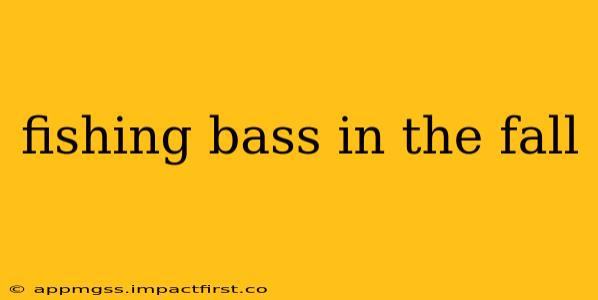Fall is a prime time for bass fishing, offering anglers a unique opportunity to target these elusive game fish. As the leaves change color and the air turns crisp, bass behavior shifts, creating exciting challenges and rewarding catches for those who understand their autumnal patterns. This comprehensive guide will delve into the intricacies of fall bass fishing, covering everything from location and techniques to tackle and seasonal considerations.
Where to Find Bass in the Fall?
One of the biggest shifts in fall bass behavior is their movement. As water temperatures cool, bass become less active in their summer haunts, seeking out specific areas for feeding and overwintering.
-
Shallow Water Structure: While some bass will move to deeper water, many remain in shallower areas, focusing on key structural elements. Look for points, submerged weed beds (particularly those with decaying vegetation), fallen trees, and docks. These areas provide both cover and ambush points for feeding bass.
-
Transitional Areas: Pay close attention to areas where shallow and deep water meet. These transitions often hold concentrated numbers of baitfish, attracting bass looking for an easy meal. This might include drop-offs, creek channels, and submerged humps.
-
Deep Water Habitats: As the water continues to cool, bass will start moving to deeper water for the winter. Look for deep structure like submerged ledges, channels, and underwater points. These locations offer protection and more stable water temperatures.
What Techniques Work Best for Fall Bass Fishing?
Fall bass fishing necessitates a shift in technique as well as location. The cooler water temperatures and changing feeding patterns require anglers to adapt their approach.
-
Slow and Steady: Unlike the aggressive strikes of summer, fall bass tend to be more methodical. Slow-rolling crankbaits, Texas-rigged worms, and jigs are highly effective. The key is to allow the bait to sit and entice the bass to react.
-
Focus on the Bottom: With bass often relating to bottom structure in the fall, bottom-contact lures become essential. Carolina rigs, drop-shot rigs, and shaky heads allow you to effectively present your bait near the bottom where the bass are most likely to be found.
-
Observe Water Temperature: Monitor the water temperature closely. Cooler water typically means slower bass, requiring even slower presentations and longer pauses.
What Baits are Most Effective in the Fall?
Choosing the right bait is crucial for fall bass fishing success. The key is to select lures that mimic the natural prey that bass are targeting during this season.
-
Crankbaits: Slow-moving, deep-diving crankbaits are excellent for covering water and probing deep structure. Choose colors that mimic shad or crayfish.
-
Jig and Pig: A jig and trailer combination is an incredibly versatile bait that excels in a variety of fall conditions. Experiment with different jig weights and trailer styles to find what works best in your chosen location.
-
Worms: Texas-rigged worms, especially in darker colors like brown, green pumpkin, or black, can be incredibly effective for targeting bass holding close to cover.
What Time of Day is Best for Fall Bass Fishing?
While bass can be caught throughout the day during the fall, there are certain periods that often produce better results.
-
Early Morning and Late Afternoon: These times often offer the most consistent action. As the water temperature fluctuates, bass become more active, especially during these transitional periods.
-
Cloudy Days: Cloudy or overcast days can also be productive, as the reduced sunlight often makes bass more willing to feed.
How Does Weather Affect Fall Bass Fishing?
Weather plays a significant role in fall bass fishing success.
-
Temperature Changes: Sharp drops in temperature can temporarily slow down bass activity, while gradual cooling often leads to steadier feeding.
-
Barometric Pressure: Bass are sensitive to barometric pressure changes. Generally, stable or slightly falling pressure is better than rapidly changing pressure.
-
Wind: Wind can push baitfish into certain areas, concentrating bass activity. Windy days can also improve your presentation by creating subtle movements in your lures.
What Tackle Should I Use for Fall Bass Fishing?
Choosing the right tackle is essential for successful fall bass fishing. Heavier tackle is often necessary to handle larger bass and effectively manage heavier lures.
-
Rods: Medium-heavy to heavy power rods are recommended for handling jigs, crankbaits, and other fall lures.
-
Reels: Reliable reels with a smooth drag system are essential for setting the hook and landing larger bass.
-
Line: Monofilament or fluorocarbon line in 12-17 lb test is generally a good choice.
This guide offers a starting point for your fall bass fishing adventures. Remember to adapt your techniques and approach based on specific conditions. Happy fishing!
